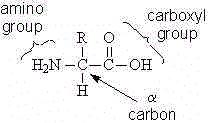


DNA is the basic hereditary material in all cells and contains
all the information necessary to make proteins.
DNA is a linear polymer that is made up of nucleotide units. The nucleotide
unit consists of a base, a deoxyribose sugar, and a phosphate. There are
four types of bases: adenine (A), thymine (T), guanine (G), and cytosine
(C). Each base is connected to a sugar via a ß glycosyl linkage.
The nucleotide units are connected via the O3' and O5' atoms forming phosphodiester
linkages.
In normal DNA, the bases form pairs: A to T and G to C. This
is called complementarity. A duplex of DNA is formed by two complementary
chains that are arranged in an anti-parallel manner.


Each amino acid has a different side chain (or R group). The side chains vary greatly in their complexity and properties. The side chain of glycine is simply a hydrogen. The side chain of tryptophan is based on the aromatic, bicyclic indole group. Amino acids are classified by the chemical nature of their side chains. One useful classification of the amino acids divides them into two groups, the polar (or hydrophilic) amino acids have side chains that interact with water, while those of the nonpolar (or hydrophobic) amino acids do not.
Each amino acid has its own specific code, made
up of three bases called a codon. This is what the RNA sequence is made
of. The mRNA then travels into the cytoplasm of the cells where proteins
are then synthesized. tRNA
(transfer RNA) brings amino acids to the mRNA.
The tRNA has a loop called the anticodon, which has the opposite sequence
of letters than the mRNA, which hooks up to the mRNA at its complementary
spot. Each of these tRNA can pick up a certain amino acid according to
its sequence of bases. When one tRNA after another connects to the mRNA,
a hydrogen bond is formed between the amino acids, forming a protein.